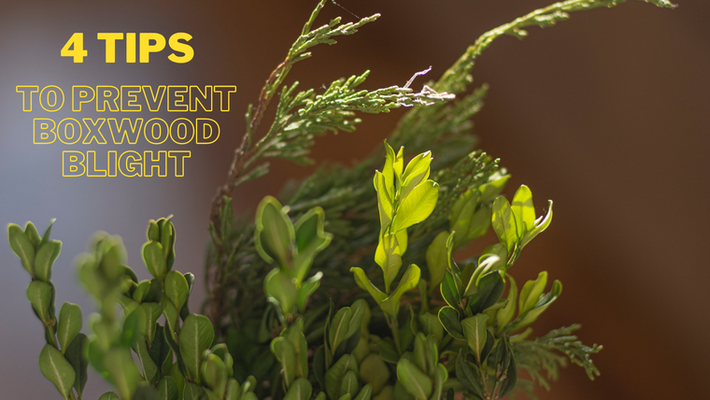
Boxwood blight, also known as boxwood blight disease or box blight, is one of the most serious issues that may affect your boxwood plants, so it’s important to know how to prevent it! While there are chemicals you can use to treat the disease if you notice it in your plants, prevention will save you time and effort in the long run.
Boxwood blight spreads quickly and can even kill your boxwood if not taken care of immediately. Here are four tips to prevent boxwood blight from affecting your landscape.
Get Tree and Plant Care Quotes Today
1) Identify Boxwood Problems
When something goes wrong with your boxwoods, it can be difficult to figure out what’s causing it. The disease is a common culprit—specifically, boxwood blight, a fungal infection that causes dark spots on foliage and eventual dieback of branches.
Boxwood blight can be prevented if you know what’s causing your boxwoods problems and are proactive about addressing those issues before they cause damage. Avoid these four mistakes, for example, and your plants should remain disease-free all season long. Or at least until fall. (Then they will almost certainly succumb to winter cold.)
If you live in an area where serious winter weather is common, try moving or planting boxwoods in partial shade; both of these strategies help keep leaves healthy and less susceptible to frost burn. You can also mulch around your plants to reduce frost damage by insulating roots from freezing temperatures. It sounds hokey, but I've found that keeping leaves free from debris helps reduce instances of leaf fall early in autumn—and so keeps them looking good all through fall as well!
2) Learn About Fungal Diseases
Fungal diseases can be a serious problem for those who love their green spaces. But there are ways you can prevent them from making your boxwoods look bad. Here are 4 tips to help keep your boxwoods healthy and looking beautiful:
1. Know When Fungal Diseases Strike Fungal diseases often appear when conditions are hot and humid—between April and October, in other words.
2. Check Your Soil Conditions and Watering Habits No soil, not enough water, or too much water could all contribute to your boxwood being struck by fungal disease.
3. Plan ahead now is a good time to plan ahead for spring. That way, you’ll be able to take advantage of cooler weather so that any diseased leaves will fall off naturally.
4. Focus on Removing Mildly Diseased Leaves This will reduce stress on your plant and allow it time to recover without becoming even more infested than it already is.
3) Use the Right Fertilizer
When using fertilizers, it’s important to only use ones labeled for boxwoods. These fertilizers contain high levels of phosphorous that are specifically beneficial for slow-growing boxwoods. Many fertilizers available in hardware stores contain too much nitrogen, which will kill your boxwood plants. If you’re not sure if fertilizer is meant for your type of plant, ask your local garden center before buying it.
It’s also important to make sure you apply enough fertilizer each time; overwatering can make your soil nutrients run low and leave you vulnerable to blight as well. You should be applying between three and five ounces per gallon of water when watering with a hose or soaker system. Watch out for burn or scorching when applying fertilizers with sprinklers because they spray more concentrated amounts over larger areas than hose or soaker systems do.
Never fertilize new plantings for at least three months after planting them! Fertilizers can stunt growth during that critical period. After three months have passed, add an application of half an ounce to one ounce of fertilizer every two weeks until fall. Don't feed again until springtime unless you notice brown tips on your new leaves.
4) Water Smartly
One of the best ways to prevent boxwood blight is to keep your plant hydrated. Overwatering can cause roots to rot and deteriorate, which will make them more susceptible to external factors such as pest damage and disease.
Water your plants regularly—but always allow it a few days between watering. Soil should never be soggy, especially near its roots, so check for moisture by sticking your finger about 3 inches into the soil (don't let it touch its roots). If the soil feels dry, water immediately; if it feels moist or wet, give it another day or two before watering again. This extra time allows air to circulate around leaves, encouraging better photosynthesis. In most climates, you'll need to water only once per week during the fall and winter months.
Check your plant often in case environmental conditions change; it's OK if you find yourself needing to water twice per week sometimes, but any less than that is ideal. During the summer months when sun exposure increases, consider increasing watering frequency to twice per week.
To avoid over-watering your plants, set an alert on your phone when it's time to water so you don't forget! To see how much water each plant needs daily, search on Google for [type of plant] + how much water. Remember: there are no exact amounts here; every region has different humidity levels and different seasonal weather patterns.
For example, succulents will require different levels of weekly/daily watering depending on where they live because some regions are very humid all year long while others go weeks without rain during summertime.
1. Register your company
2. Create a searchable listing
3. Connect with more clients
